Foods of Rome – The Ultimate Rome Foodie Guide
So, your trip to Rome is booked and all planned out.
You know exactly what your schedule looks like, and you’ve made sure to include a spot on your itinerary for each and every major attraction that Rome has to offer.
There’s just one thing you haven’t factored in yet – the foods of Rome.
Many visitors to Rome end up leaving the Eternal City disappointed by Roman food.
They talk about being scammed, of being served underwhelming meals at extortionate prices, and how Italian food isn’t all it’s cracked up to be.
You may even remember Molly-Mae Hague branding ‘Italian food in general‘ as ‘grim‘ and ‘shocking‘ a couple of years ago – a sentiment that a lot of tourists visiting Italy for the first time happened to agree with!
However, as a committed Italophile, I am here to tell you that the foods of Rome are incredible, and that on my recent trip to Rome with Jet2holidays, I ate like a goddamn QUEEN, and discovered so many Rome foods that I didn’t even know existed prior to my trip!
So, with that in mind, I decided to put together this Rome foodie guide, so that you can enjoy all of the wonderful foods of Rome without being scammed or feeling disappointed.
I’ve included an overview of Roman cuisine, a list of typical Roman dishes you absolutely have to try when you visit Rome, my favourite restaurants in Rome, and some unique gastro experiences that you can add to your Rome itinerary.
So, if you’re ready, then let’s get into it!
The Foods of Rome – The Ultimate Rome Foodie Guide
What is traditional Roman food like?
Roman cuisine is hearty and simple, relying on fresh ingredients and bold flavours.
Pasta dishes are a Roman staple, often made with sauces based on cured pork products like pancetta and guanciale, as well as salty Pecorino Romano cheese.
Rich, hearty stews are also popular in Rome, and you will also find a lot of offal in Roman dishes (similar to the food in Palermo, Sicily).
Seasonal ingredients and vegetables like artichokes, fava beans, and courgettes (zucchini) also feature prominently.
Roman food is best enjoyed in informal, family-style trattorias, accompanied by copious amounts of local wine.
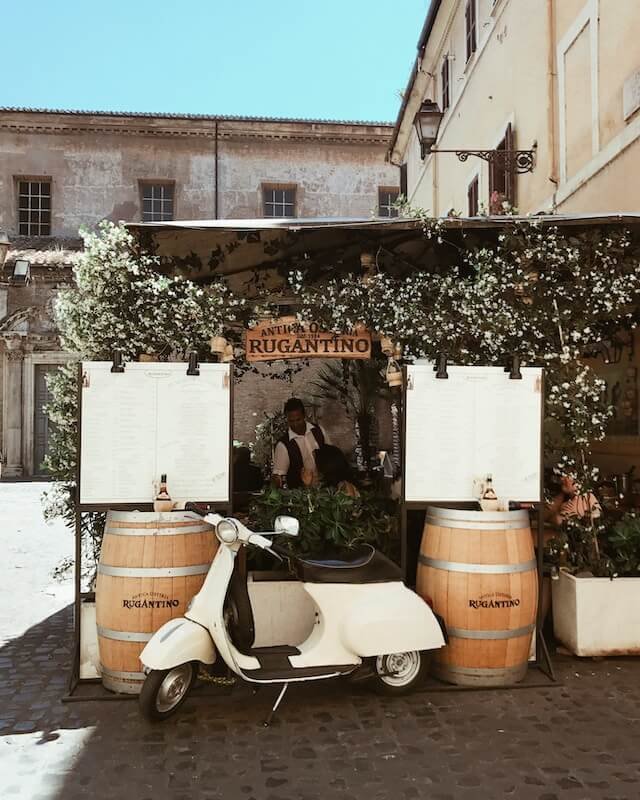
Key ingredients in Roman cuisine
Artichokes
Artichokes are a staple in Roman cuisine and are used in many traditional Roman dishes.
Some popular artichoke dishes from Rome include Carciofi alla Romana and Carciofi alla Giudia, which I will go into in more detail later.
Cheese
The most commonly used cheese in Roman cooking is Pecorino Romano, a sheep cheese with a sharp and salty flavour.
Pecorino Romano is frequently used as a grating cheese on pasta dishes, or mixed into the sauce.
Pasta
If you’ve ever been to Italy, you will know that the different types of pasta are endless, and Italians feel very strongly about which types of pasta should be used for which dish.
The most popular types of pasta in Roma are bucatini, spaghetti, tonnarelli (like spaghetti, but thicker), and fettuccine.
Chicory
I hadn’t actually tried chicory before I visited Rome, but it is a bitter green that is very popular in Rome during the winter.
You will often see chicory listed as a side dish on the menus of trattorias, and it is usually sautéed with olive oil, plenty of garlic, and a touch of chili.
Guanciale
Guanciale is cured pork cheek that is very salty, and has a high fat-to-meat ratio, so when it cooks, the fat renders and creates a lump of crispy meat.
You will find guanciale in a lot of pasta dishes.
Offal
If you’re an adventurous eater, then you will definitely enjoy some of the more unusual foods of Rome!
Offal is a cornerstone of Roman cuisine, and you will find tripe, liver, heart, intestines, and even brain on the menus of Rome’s restaurants.
Wine
Good Roman food always tastes better when served with a great local wine!
In pretty much all of Rome’s restaurants, you can ask for vino della casa (house wine) and you’ll usually be served from a carafe that comes in a half or full litre.
Just say whether you want red or white, and you will be served some of the best (and cheapest!) wine you’ve ever tasted.
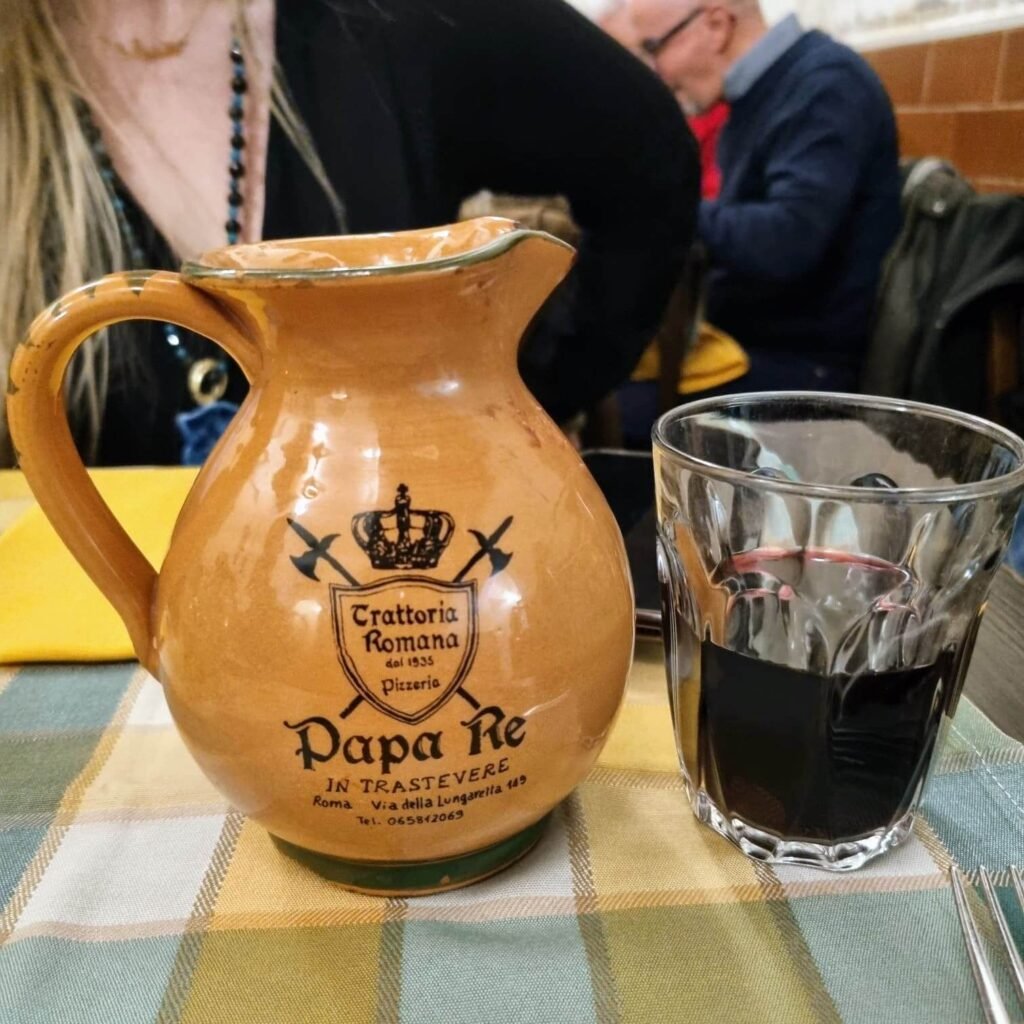
What to eat in Rome – Rome foods you must try
Meat and fish dishes
Saltimbocca alla Romana
This dish is considered so flavourful that it literally ‘jumps in your mouth,’ which is what saltimbocca translates to!
Saltimbocca alla Romana is made with pounded veal medallions, dressed with salty prosciutto and sage and finished in white wine and butter.
Saltimbocca is a second course, to be ordered alongside vegetables.
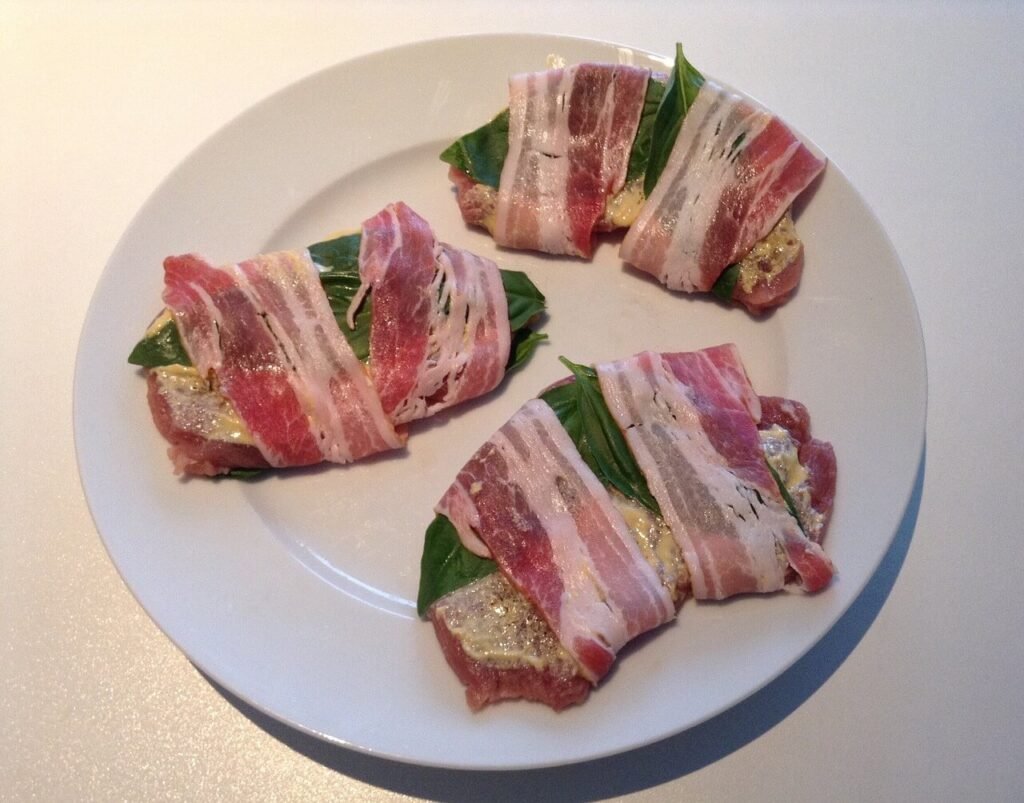
Coda alla Vaccinara
Coda alla Vaccinara was one of my favourite foods of Rome.
It refers to a traditional Roman stew of slow-braised oxtail, served in a delicate tomato sauce with vegetables, red wine, and herbs.
Oxtail is a fairly common food in Valencia (where I used to live), so I’ve been a fan for a while!
Although oxtail is considered offal, it’s really just a fatty cut of beef that falls off the bone and absolutely melts in the mouth – if you want to really eat like a Roman, pick up the bones and suck the meat off for all the best flavours!
Be sure to use a thick hunk of crusty bread (known as a scarpetta) to mop up all that delicious sauce when you’re finished!
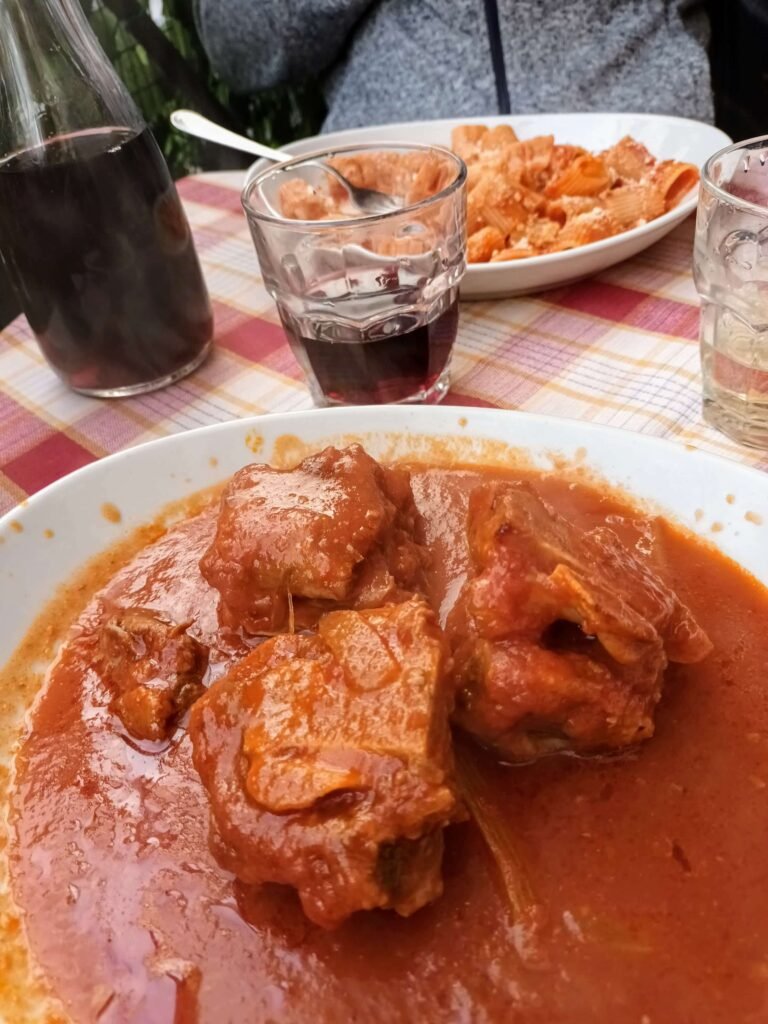
Abbacchio a Scottadito
Abbacchio a scottadito is a traditional Roman dish made from young lamb which has not yet weaned from its mothers milk.
The dish is named after the Italian phrase ‘scottadito,’ which means ‘burned fingers,’ referring to the fact that this juicy meat is cooked so well that you can’t help but eat with your fingers piping hot!
Abbacchio a Scottadito is typically made by grilling the lamb chops over an open flame until they are cooked through and crispy on the outside, before seasoning them with salt, pepper, garlic, and rosemary and serving with a drizzle of extra virgin olive oil (EVOO) and a squeeze of lemon juice.
Pollo alla Romana
Also called Pollo con Peperoni (which means peppers, not ‘pepperoni’), Pollo alla Romana is a chicken dish made from the juiciest parts of the chicken (think wings and legs) and slow-cooked with peppers, EVOO, and tomatoes.
Pollo alla Romana is one of the only chicken dishes you’ll find in Italy, and that’s because Italian’s consider chicken to be a bland and tasteless meat!
Coratella con Carciofi
Coratella is an offal dish that is not for the fainthearted – I consider myself to be a pretty adventurous eater, but this was hardcore!
This incredibly rich combination of brain, liver, and heart (sometimes with the addition of lungs) is mixed with crispy fried artichokes.
This dish is usually served as a side dish and shared, but I ordered it as a main, and found it a bit much!

Trippa alla Romana
Another cornerstone of Roman cuisine is Trippa alla Romana, cow’s stomach that is sliced into thick strips and served in a sauce made of guanciale, onion, garlic, mint, carrots, celery, cloves, and tomato.
One for the adventurous eaters this is traditionally a poor man’s dish, and although the honeycomb texture might take a bit of getting used to, it’s worth the effort!
Trippa alla Romana is high in protein yet low in fat, making it a surprisingly healthy dish!
If you’re a fan of tripe, you may enjoy flaki, a Polish soup made with tripe!
Filetti di Baccalà
Filetti di Baccalà is salted cod, that is deep-fried and served in bitesized chunks.
Kinda like the Italian answer to fish n’ chips (only without the chips), Filetti di Baccalà is comfort food, plain and simple.
Polpette alla Romana
Polpette alla Romana, or Roman-style meatballs, are made with ground beef, breadcrumbs, Pecorino cheese, eggs, milk, and spices.
The mixture is formed into small balls, which are then fried in a pan until they are crispy on the outside and tender on the inside.
Unlike meatball dishes in the UK, Roman meatballs are not served with spaghetti (!). They come served alone, sometimes with a bit of sauce, and can be ordered as an appetiser or main course.
Vegetable dishes
Carciofi alla Romana
Carciofi alla Romana is a traditional Roman food made with whole artichokes that are braised with garlic, mint, parsley, white wine, and olive oil.
The artichokes are typically cut into quarters and boiled until they are tender, before being served cold as a side dish.
Carciofi alla Giudia
The only thing that Jewish artichokes share with Roman artichokes is, well, the fact that they are both made with artichokes.
In every other way, these iconic Roman foods are worlds apart.
Jewish artichokes are seasoned with salt and pepper before being fried twice in olive oil – yes, twice – to make them super crispy on the outside yet tender on the inside.

Gnocchi alla Romana
Nothing says ‘comfort food’ like Gnocchi alla Romana.
Gnocchi alla Romana is not like the regular gnocchi you’re probably familiar with – Gnocchi alla Romana is instead made with semolina which is cooked in milk, eggs, butter and Parmesan cheese and baked until golden and crispy.
Roman street food
Supplì
Suppli are a type of fried rice ball that are popular in Rome, and they make a great snack on-the-go!
Suppli are balls of risotto rice stuffed with a mixture of marinara sauce, mozzarella cheese, and often meat, which are coated in breadcrumbs and deep-fried until they are crispy and golden brown.
Biting into the warm, gooey centre, with its stringy melted cheese, is super satisfying, and whether you’re trying to eat cheap in Rome or looking for some stodgy comfort food, the Roman answer to Sicilian arancine will do just the trick.
Maritozzi
While not a street food per se, maritozzi are a popular Roman pastry that can be eaten quickly and cheaply on the go.
Maritozzi are made with a soft dough, filled with a sweet and creamy filling, and sprinkled with powdered sugar.
They are a staple Roman breakfast pastry, or you can enjoy them as a sweet treat at any time of day! pastry shops and bakeries and are enjoyed with coffee or as a sweet treat any time of day.
Pizza al Taglio
Pizza by the slice is a quintessential Roman street food (and Italian street food in general), and while Italians generally prefer simple toppings of tomato sauce and mozzarella, you can head to the fiercely popular Bonci Pizzarium for a more creative twist on the classic margherita pizza.
Here, Gabriele Bonci’s toppings include figs, pumpkin puree, foie gras, black truffle, and more, and while you may have to wait in line for a while, you’ll be glad you did.
If you prefer something a bit less fancy, you can pick up pizza al taglio all around the city for a couple of euros, making it one of the best choices for cheap eats in Rome.
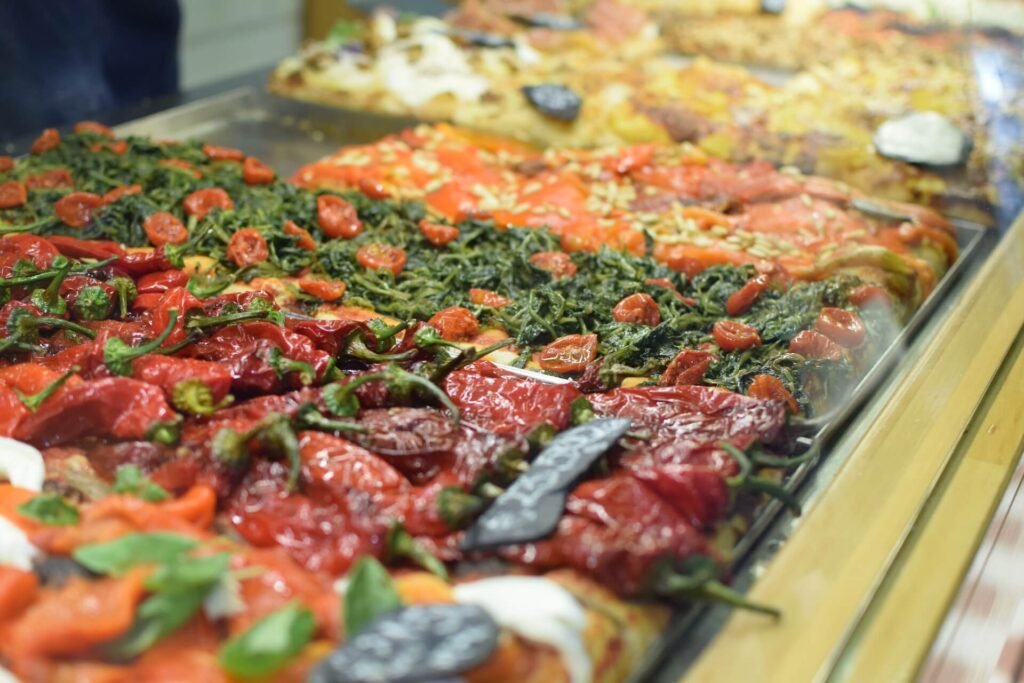
Trapizzino
Trapizzino is a popular street food dish that actually originated in Italy’s capital!
A trapizzino is essentially a triangular-shaped pizza-cum-sandwich stuffed with various ingredients, from ragù meat sauce to spicy chicken, meatballs, and more.
Trapizzino is now a staple of Roman street food, and another one of the best foods to try in Rome if you’re watching your budget (and in general!).
Panino con la Porchetta
Panino simply means ‘sandwich,’ and a porchetta panino is one of the yummiest things you can get your hands on in Italy.
Porchetta is a full, deboned pig that is stuffed with wild fennel, garlic, and offal, seasoned with salt, pepper, and other herbs, and slow-roasted on a spit for at least 8 hours to ensure the most juicy and tender meat possible.
The skin is left on to create a scrumptious crackling, and the finished dish is sliced and served either as a main course, or on a sandwich made of thick crusty bread (you can even have porchetta in a trapizzino!).
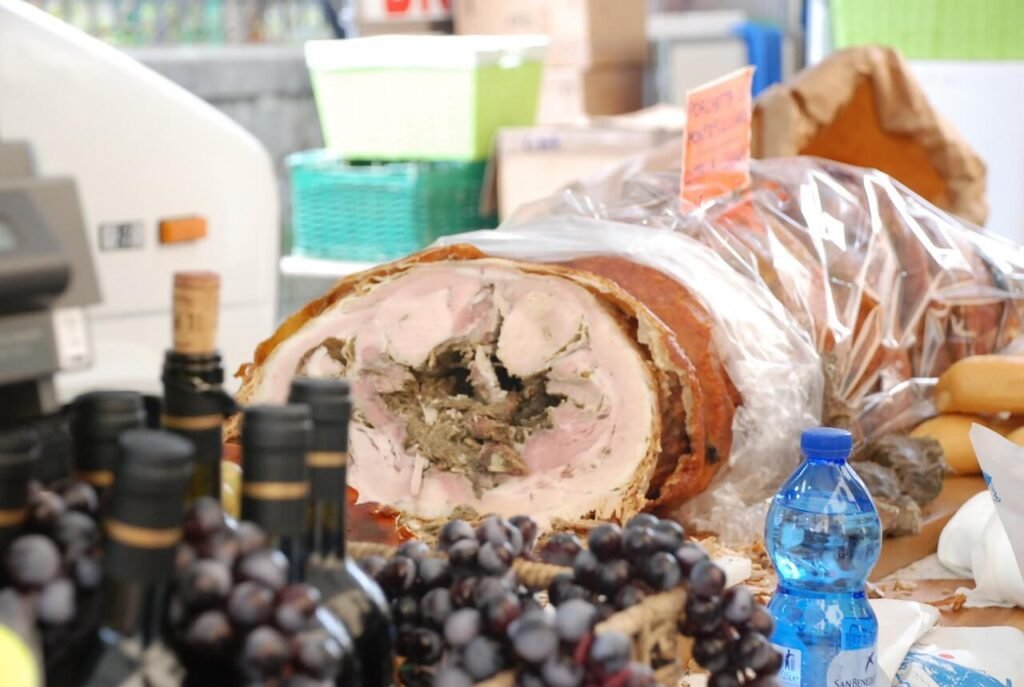
Pasta dishes
Cacio e Pepe
Cacio e pepe is one of Rome’s most iconic dishes, and despite how simple it may sound, it is actually very difficult to get right if you don’t get the proportion of cheese and temperature of the pasta exactly right.
Spaghetti or tonnarelli is tossed with cacio (the local word for Pecorino Romano), and pepe (black pepper).
The salty, tangy flavour of the Pecorino Romano, combined with the kick of black pepper make for a comforting meal that you will be thinking about long after you’ve left Rome – in fact, the late Anthony Bourdain proclaimed that cacio e pepe ‘could be the greatest thing in the history of the world.’
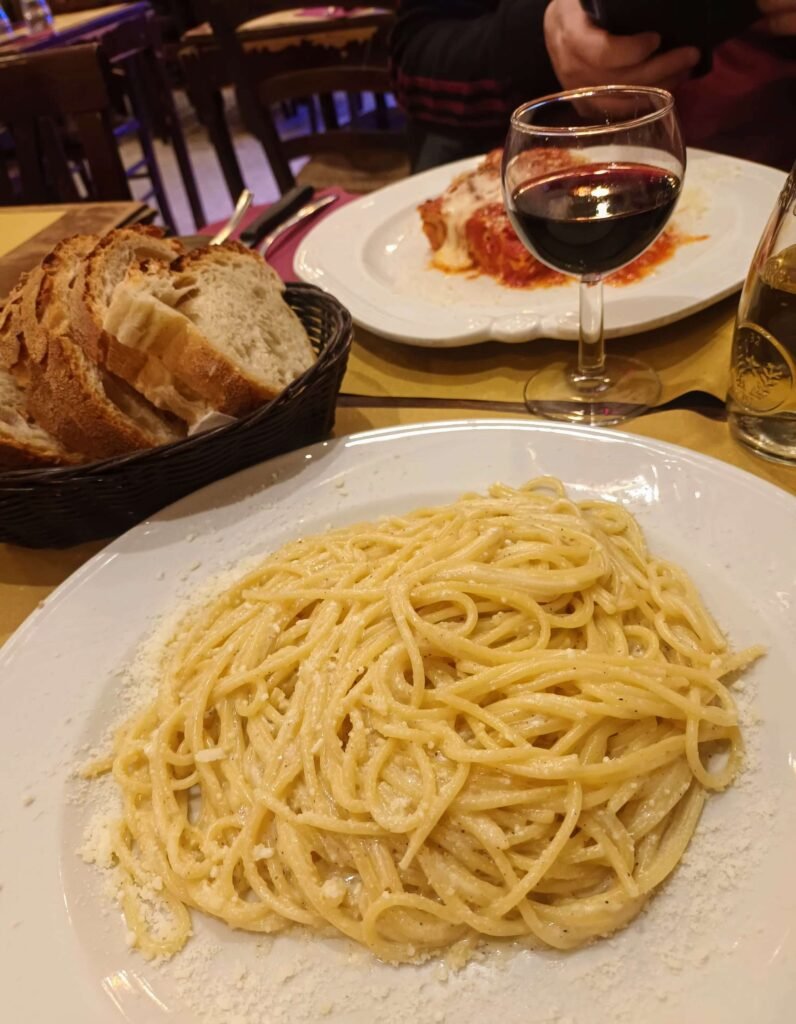
Bucatini all’Amatriciana
Hailing from the small town of Amatrice, in the Lazio region of Italy (which includes Rome), Bucatini all’Amatriciana of one of the most famous foods of Rome, and for good reason!
Bucatini pasta (or sometimes rigatoni) is served al dente with a sauce made from fresh tomatoes, guanciale, EVOO, dry white wine, red chili peppers, and grated Pecorino Romano cheese.
The freshness of the ingredients combine with the rich salty flavours of the cheese and guanciale to make an absolutely delicious dish, and it’s definitely one of the main foods to try in Rome.
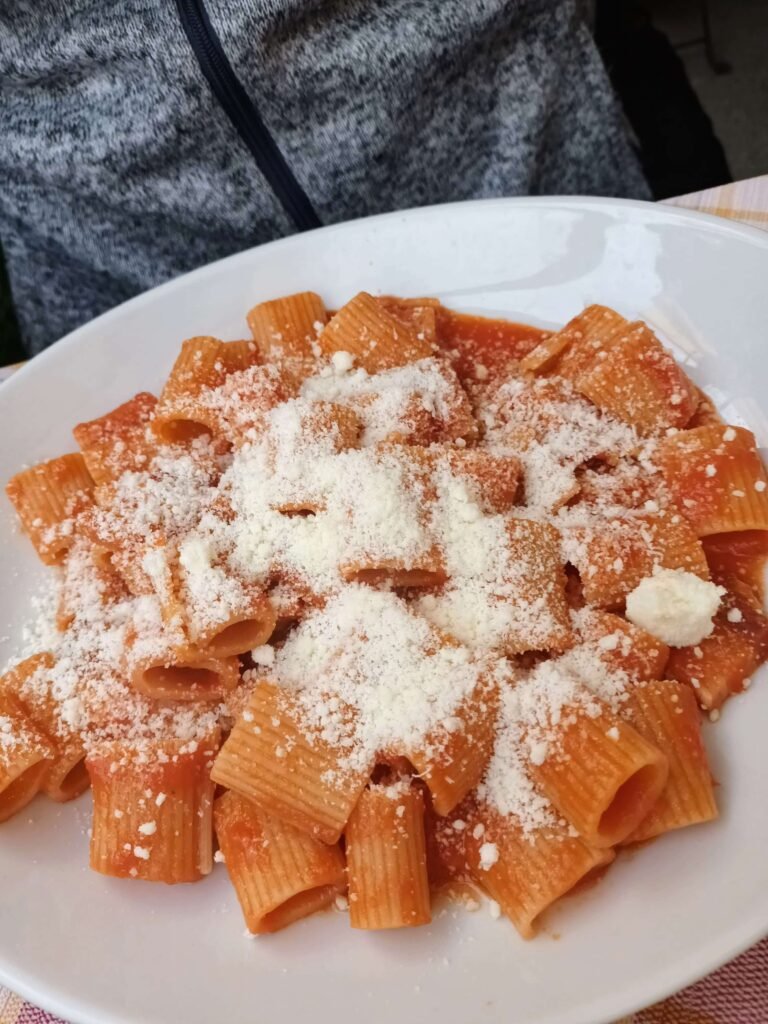
La carbonara
When it comes to traditional Roman food, La Carbonara is about the most famous you can get!
The dish is made with either spaghetti or rigatoni pasta, guanciale, a raw egg, Pecorino Romano cheese, and black pepper.
Contrary to what you may have tried in the US or UK, carbonara is never made with cream in Italy – instead, the egg is gently heated with the starchy pasta water to create a thicker sauce.

Bombolotti con Pajata
If you’re looking for some more adventurous Rome foods, Pajata is something to put on your list.
Pajata is a traditional Roman dish made from the intestine of an unweaned calf or lamb.
The intestine (pajata) still contains partially digested milk from the animal’s mother, which curdles and cooks inside the intestine as it is simmered in a tomato sauce with garlic, onion, and herbs.
Usually, pajata is served with bombolotti pasta, but it can also come with mashed potato, polenta, or rigatoni.
Not one for the fainthearted, pajata is nevertheless a staple of traditional Roman cuisine, and is difficult to find outside of the region.
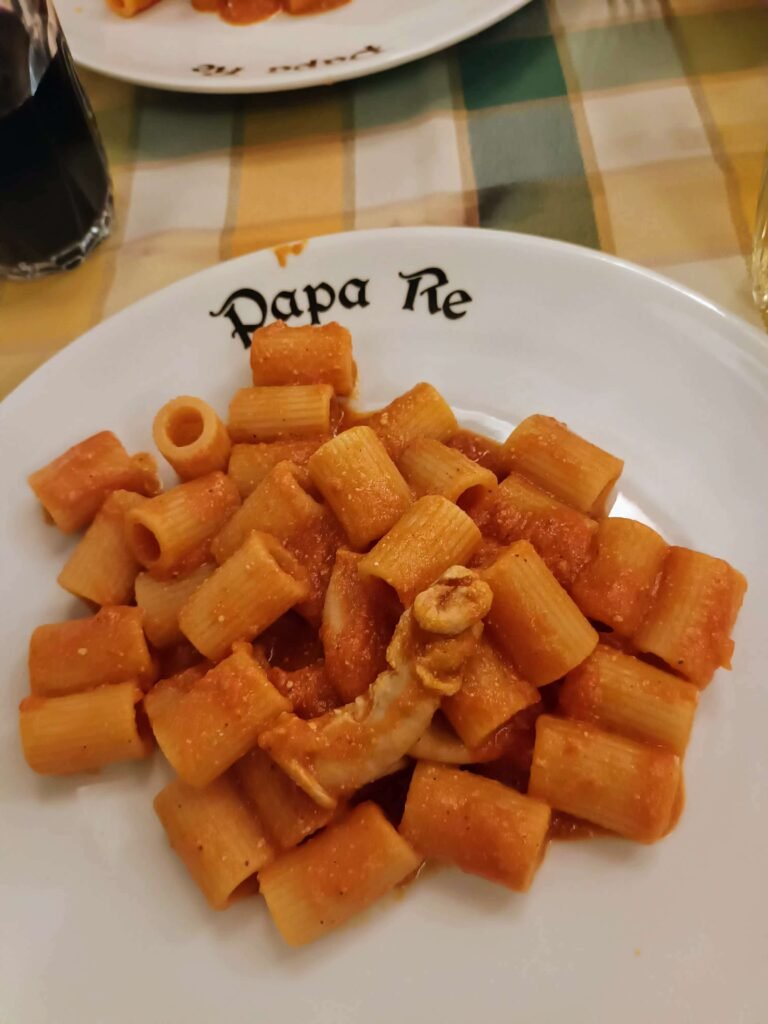
Gnocchi con Sugo di Carne
Usually only served on Thursdays (one of the many weird and wonderful Italian quirks), Gnocchi con Sugo di Carne is good old-fashioned potato gnocchi served with a tomato and meat sauce.
Find it in family trattorias, homemade by a Roman nonna.
La Gricia
The last of Rome’s most famous pasta dishes, La Gricia is similar to La Carbonara, only with no eggs.
Cooked with guanciale, Pecorino cheese, and black pepper, La Gricia was apparently invented by shepherds from Lazio who didn’t have access to many ingredients, so made the best with what they had.
However, La Gricia certainly isn’t lacking in flavour, with the salty sheep cheese, bold guanciale, and sharp black pepper all packing a mighty punch.
How to eat like a local in Rome
It isn’t difficult to find delicious, authentic, and affordable food in Rome, but every year, thousands of tourists end up being ripped off and having bad experiences at Roman restaurants.
Luckily, if you know what to avoid, you’ll be absolutely fine when it comes to eating out in Rome.
Here are my best tips to ensure a great experience:
- Avoid restaurants near Trevi, the Colosseum, and The Vatican. These are the infamous ‘tourist trap’ places that will charge extortionate amounts of money for mediocre food.
- Restaurants in the Historical Centre of Rome will be more expensive than those in other neighbourhoods, but are still usually pretty good value for money.
- Trastevere is a great neighbourhood, both for value and quality of food.
- Check the prices before you sit down anywhere, and avoid restaurants where a server is standing outside trying to entice people in.
- Bear in mind that in Italy, most restaurants do not open before 7/8pm.
- Check if there is a coperto, or ‘table charge.’ I didn’t get stung with this in Rome, but you never know. You don’t want to order a 2 EUR coffee and end up paying double that just to sit down and drink it!
- Italians never order a cappuccino in the afternoon, but if you want one, go for it. They are used to tourists, so don’t sweat your coffee order too much.
- Breakfast in Italy is a simple affair. Read my guide to Italian breakfasts to see what to expect.
- Many of Rome’s popular restaurants are booked way in advance. We had to queue even on a rainy night in January to get in anywhere in Trastevere, so be sure to call in advance and make a reservation.
- You’ll certainly want to eat gelato in Rome, but watch out for colours that seem too bright or gelato that seems too fluffy. The best gelato never looks too artificial.

Where to eat in Rome
There are thousands of restaurants in Rome and so I couldn’t possibly tell you which are the best ones, but here are the ones that I personally tried, as well as a couple that my friend (who has lived in Rome for over a decade) recommended to me.
Miscellanea Pub – located down an unassuming street close to the Pantheon (in the Historical Centre), Miscellanea is a self-proclaimed ‘international students pub’ (that is really more of an old-fashioned trattoria), where you can enjoy reasonably-priced Roman classics. Ethan and I opted for cacio e pepe and lasagne al ragu, and together with wine, bread, fruit and a digestivo shot, the total bill came to just over 30 EUR.
Antica Osteria Rugantino – Rugantino is in the hipster Trastevere district, and was where I went for my first evening meal in Rome. We ordered a selection of Rome’s famous pastas (pictured below) and were very impressed.
Papa Re – We enjoyed a fantastic meal at Papa Re, and the total bill for a pasta starter to share, two main courses, two desserts, and two bottles of wine, was less than 50 EUR! You’ll find all the Roman classics here, including offal dishes like pajata and coratella.
Pizzeria Luzzi – I know I said to avoid restaurants near the Colosseum, but Pizzeria Luzzi is an exception. Full of locals even on the rainiest January day, the food at Luzzi is phenomenal. We ordered tomato and mozzarella suppli, Jewish-style artichokes, Amatriciana pasta, and oxtail with tomato sauce. All of this food, plus a LITRE of wine and bread, came to a grand total of 32 EUR.
Ristorante Papetto – Located in a residential neighbourhood of Rome (you’d need to take a taxi here), Papetto is a multi-generation family trattoria that serves endless courses of seafood for a fixed price. For 40 EUR, you will get around 12 courses (including seafood pasta, a mixed seafood grill, octopus salad, and more), plus coffee, limoncello, and all the wine you can drink. Lunch at Papetto was one of the best meals I’ve ever had. Reservations are essential.
My final recommendations come from Heli, my friend in Rome. While I have personally not visited these restaurants, I trust Heli’s opinion (especially as she was the one that took me to Papetto!
The restaurants that Heli recommends Trattoria da Enzo, Da Teo, and Le Mani in Pasta, all located in Trastevere.
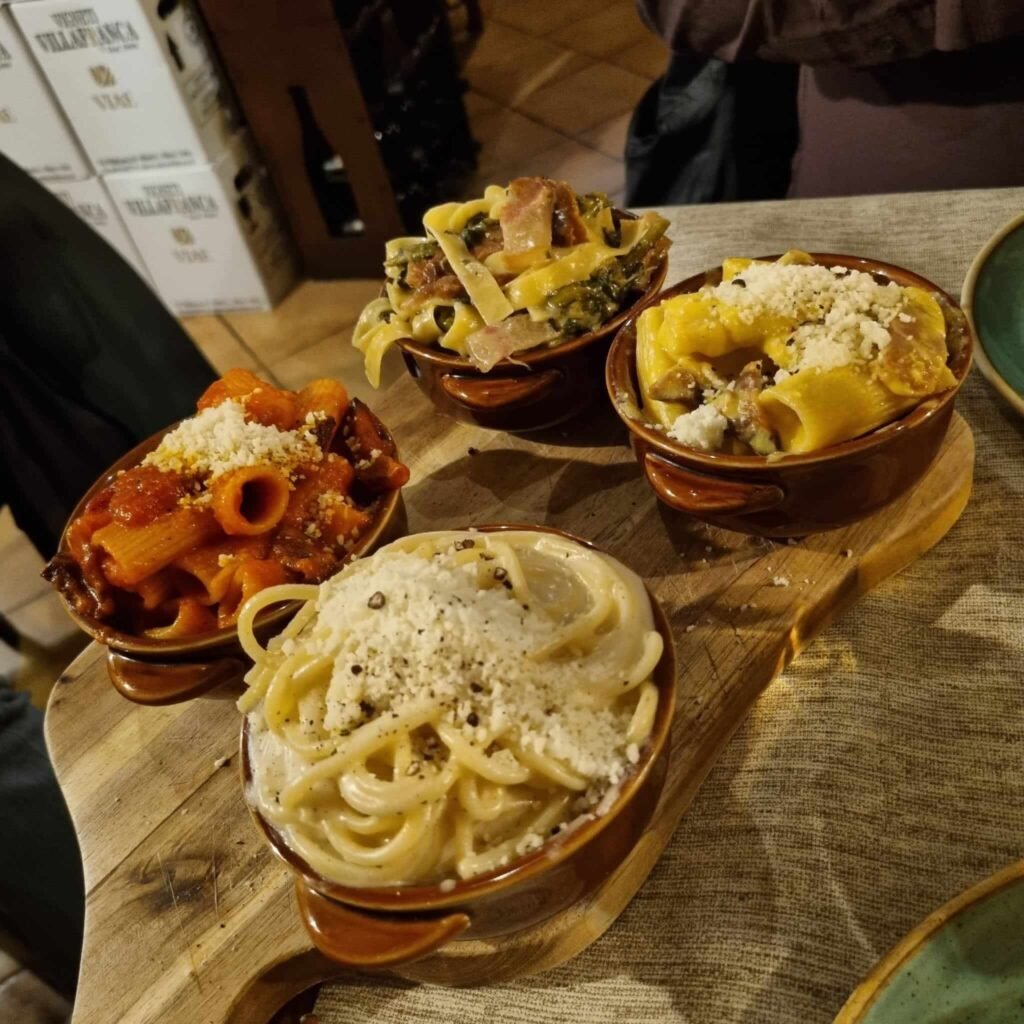
Rome food tours
One of the best ways to try all the delicious foods of Rome is by joining a Rome food tour.
I love taking part in food tours, cooking classes, and other gastro experiences when I travel, and although I didn’t get to try any food tours in Rome when I visited, I definitely would in the future.
Here are the highest-rated Rome food tours that I like the look of:
Rome Street Food Tour With Local Guide
Trastevere Sunset Food Tour With Guide
Food Tour and Wine Tasting in a Traditional Trattoria
4-Hour Food Tour by Night
Jewish Ghetto and Campo de Fiori by Night Food Tour
Foods of Rome | Final Thoughts
So, that just about brings us to the end of my Rome foodie guide!
Hopefully by now, you have a list as long as your arm of the best Roman foods, restaurants, and gastronomic experiences you need to have when you visit Rome.
As always, if you have any questions, don’t hesitate to reach out in the comments section below and I will get back to you.
Until next time,
XOXO
If you liked this article and would like to support my work, please click the button above to donate a couple of bucks and buy me a coffee. The ad revenue that I receive on this website is minimal, so support from my readers enables me to keep creating content that you (hopefully!) love to read.
